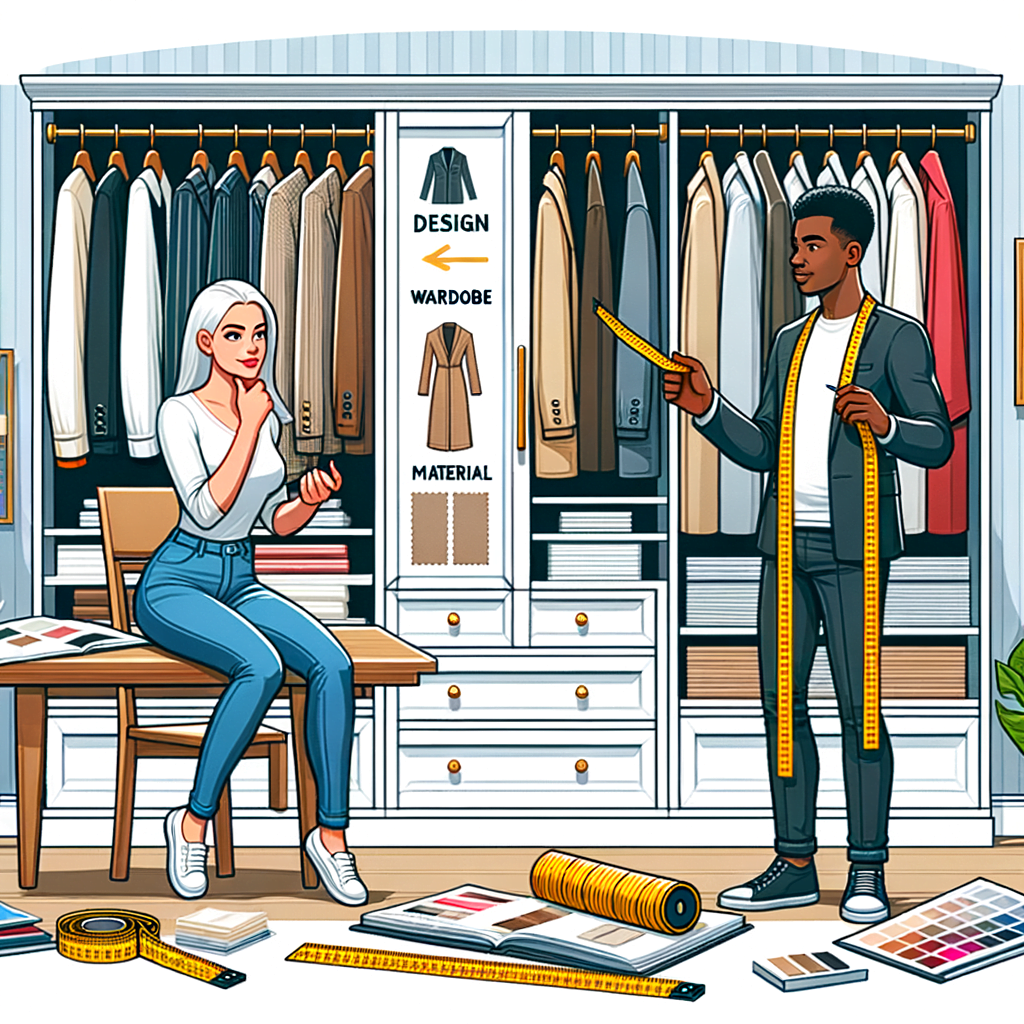Assessing Your Storage Needs
When choosing custom wardrobes, it is imperative to begin by thoroughly assessing your storage needs. This initial step is crucial as it lays the foundation for a wardrobe that not only meets your aesthetic preferences but also serves its functional purpose effectively. To start, consider the types of items you need to store. This includes clothing, shoes, accessories, and any other personal belongings that require organized storage. By categorizing these items, you can better understand the specific storage solutions you need, such as hanging space, drawers, shelves, or specialized compartments.
Next, evaluate the quantity of each category. For instance, if you have an extensive collection of formal wear, you will need ample hanging space to prevent wrinkles and maintain the integrity of the garments. Conversely, if you possess a large number of shoes, incorporating dedicated shoe racks or shelves will be essential. Additionally, consider the frequency of use for each item. Items that are used daily should be easily accessible, while those used less frequently can be stored in less accessible areas.
Furthermore, it is important to take into account the available space in your room. Measure the dimensions of the area where the wardrobe will be installed, including height, width, and depth. This will help you determine the maximum size of the wardrobe that can fit comfortably within the space. Additionally, consider the layout of the room and how the wardrobe will interact with other furniture and fixtures. Ensuring that there is enough clearance for doors to open fully and for you to move around comfortably is essential for a functional design.
In addition to spatial considerations, think about the future. Your storage needs may evolve over time, so it is wise to plan for flexibility. Opt for adjustable shelves and rods that can be repositioned as needed. This adaptability will allow your wardrobe to accommodate changes in your wardrobe or lifestyle without requiring a complete overhaul.
Another critical aspect to consider is the material and construction of the wardrobe. High-quality materials and craftsmanship will ensure durability and longevity. While it may be tempting to cut costs, investing in a well-constructed wardrobe will save you money in the long run by reducing the need for repairs or replacements. Additionally, consider the aesthetic appeal of the materials and finishes. The wardrobe should complement the overall design of your room and reflect your personal style.
Moreover, think about the organizational features that will enhance the functionality of your wardrobe. Incorporating elements such as pull-out trays, tie racks, jewelry drawers, and built-in lighting can significantly improve the usability of the space. These features not only make it easier to find and access your belongings but also help maintain order and prevent clutter.
Lastly, do not overlook the importance of professional advice. Consulting with a designer or a specialist in custom wardrobes can provide valuable insights and recommendations tailored to your specific needs. They can help you navigate the myriad of options available and ensure that your wardrobe is both practical and aesthetically pleasing.
In conclusion, assessing your storage needs is a multifaceted process that involves careful consideration of the types and quantities of items to be stored, the available space, future flexibility, material quality, organizational features, and professional guidance. By taking a comprehensive approach, you can create a custom wardrobe that not only meets your current requirements but also adapts to your evolving needs, providing a seamless blend of functionality and style.
Selecting the Right Materials

When choosing custom wardrobes, selecting the right materials is a critical step that significantly impacts the durability, functionality, and aesthetic appeal of the final product. The first consideration should be the type of wood or wood-based material used. Solid wood, such as oak, maple, or walnut, offers unparalleled durability and a timeless look. However, it is also more expensive and may require more maintenance. For those seeking a more budget-friendly option, engineered wood products like plywood, MDF (Medium-Density Fiberboard), and particleboard can provide a similar appearance at a lower cost. Each of these materials has its own set of advantages and disadvantages, which should be carefully weighed based on your specific needs and preferences.
In addition to the primary material, the choice of finishes plays a crucial role in the overall look and feel of the wardrobe. Finishes can range from natural wood stains that highlight the grain and texture of the wood to painted surfaces that offer a sleek, modern appearance. Veneers are another popular option, providing the look of high-quality wood at a fraction of the cost. When selecting a finish, it is essential to consider not only the aesthetic but also the practicality. For instance, high-gloss finishes may look stunning but can show fingerprints and scratches more easily than matte or satin finishes.
Hardware is another important aspect to consider when selecting materials for custom wardrobes. The quality of hinges, drawer slides, and handles can greatly affect the functionality and longevity of the wardrobe. Opting for high-quality hardware ensures smooth operation and reduces the likelihood of future repairs. Soft-close mechanisms for drawers and doors are a popular choice, adding a touch of luxury and preventing the wear and tear associated with slamming.
The interior fittings and accessories also deserve careful consideration. Adjustable shelving, pull-out drawers, and specialized compartments for shoes, ties, and jewelry can enhance the usability of the wardrobe. Materials for these fittings should be chosen with the same care as the exterior, ensuring they are robust and match the overall design. Metal fittings, for example, can add a modern touch and are generally more durable than plastic alternatives.
Environmental considerations are increasingly important in material selection. Sustainable materials, such as FSC-certified wood, ensure that the wood is sourced from responsibly managed forests. Additionally, low-VOC (Volatile Organic Compounds) finishes and adhesives contribute to better indoor air quality, making the wardrobe safer for your home environment.
Budget constraints often play a significant role in material selection. While it may be tempting to cut costs by opting for cheaper materials, it is important to consider the long-term implications. Investing in higher-quality materials may result in a higher initial cost but can save money in the long run by reducing the need for repairs and replacements. A well-constructed wardrobe made from quality materials can last for decades, providing better value over time.
In conclusion, selecting the right materials for custom wardrobes involves a careful balance of aesthetics, functionality, durability, and budget. By considering factors such as the type of wood, finishes, hardware, interior fittings, environmental impact, and cost, you can make an informed decision that meets your needs and enhances your living space. Taking the time to choose the right materials will ensure that your custom wardrobe is not only beautiful but also a practical and lasting addition to your home.
Considering Design and Aesthetics
When choosing custom wardrobes, it is essential to consider design and aesthetics to ensure that the final product not only meets your functional needs but also enhances the overall look of your space. The first step in this process involves understanding your personal style and the existing decor of your room. By doing so, you can create a cohesive look that complements the rest of your home. For instance, if your room features a modern design with clean lines and minimalistic elements, you might opt for a wardrobe with sleek finishes and simple hardware. Conversely, if your space has a more traditional feel, a wardrobe with ornate details and classic materials might be more appropriate.
Transitioning from personal style to the broader context of the room, it is crucial to consider the color scheme. The wardrobe should either blend seamlessly with the existing palette or serve as a striking contrast that adds visual interest. Neutral colors like white, beige, or gray are versatile and can easily match various decor styles. However, bold colors or unique finishes can make the wardrobe a focal point in the room. Additionally, the choice of materials plays a significant role in the overall aesthetic. Wood, for example, offers a timeless appeal and can be stained or painted to match your desired look. On the other hand, materials like glass or metal can provide a contemporary edge.
Moving on to the layout and structure of the wardrobe, it is important to think about how the design will impact the room’s functionality. A well-designed wardrobe should maximize storage space while maintaining an organized and clutter-free appearance. Consider incorporating features such as adjustable shelves, pull-out drawers, and hanging rods to accommodate various types of clothing and accessories. Furthermore, the placement of the wardrobe within the room should be carefully planned to ensure it does not obstruct natural light or impede movement. Built-in wardrobes can be an excellent option for smaller spaces, as they can be customized to fit seamlessly into alcoves or awkward corners.
As we delve deeper into the design elements, the choice of hardware and accessories should not be overlooked. Handles, knobs, and hinges can significantly influence the overall look of the wardrobe. For a cohesive appearance, select hardware that matches other fixtures in the room, such as door handles or light fixtures. Additionally, consider incorporating lighting within the wardrobe to enhance visibility and add a touch of luxury. LED strip lights or spotlights can be installed inside the wardrobe to illuminate shelves and hanging areas, making it easier to find items and adding a sophisticated touch.
Finally, it is essential to think about the long-term implications of your design choices. Trends in interior design can change rapidly, so opting for a timeless design can ensure that your wardrobe remains stylish for years to come. Quality craftsmanship and durable materials are also crucial factors to consider, as they will impact the longevity and functionality of the wardrobe. Investing in a well-made, custom wardrobe can provide lasting value and enhance the overall appeal of your home.
In conclusion, when choosing custom wardrobes, careful consideration of design and aesthetics is paramount. By understanding your personal style, considering the room’s color scheme and layout, selecting appropriate materials and hardware, and thinking about long-term implications, you can create a wardrobe that is both functional and visually appealing. This thoughtful approach will ensure that your custom wardrobe not only meets your storage needs but also enhances the beauty and harmony of your living space.

